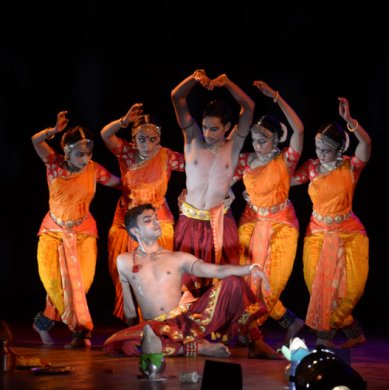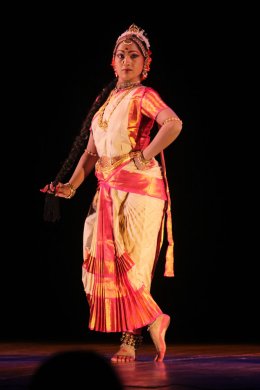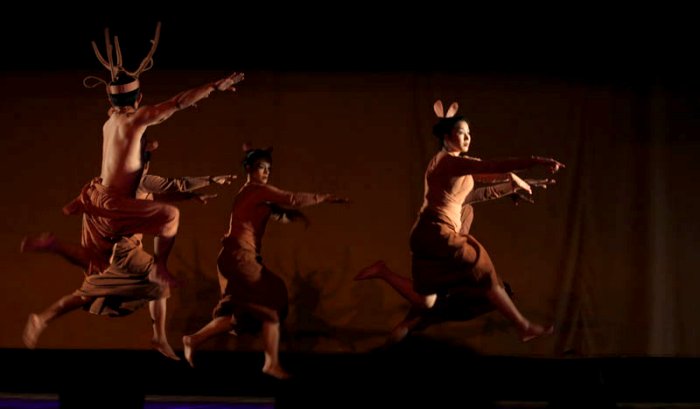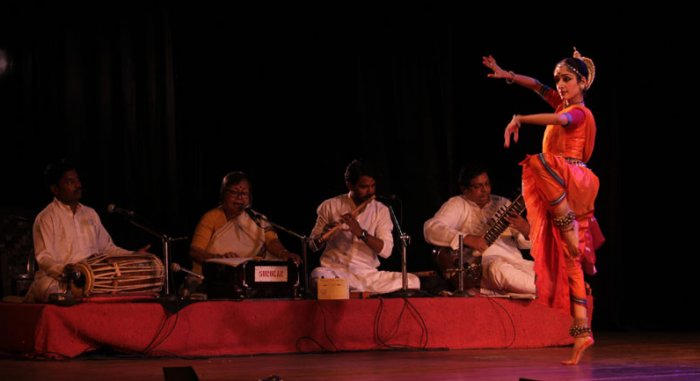
|   |

|   |
 e-mail: leelakaverivenkat@gmail.com Evening concerts after morning deliberations in Nartanam Conclave 2017 Photos: KK Gopalakrishnan October 28, 2017 Morning deliberations on dance treatises, involving scholars, artists and university research students, during the three- day Nartanam Conclave 2017, mounted at Hyderabad's Hotel Plaza, were substantiated by recitals of different classical forms in the evening. One could hardly have wished for a better start to the evening concerts than what was provided in 'Within Boundaries' by Bangalore's Bharatanatyam practitioner Parshwanath Upadhye and his Punyah group in 'Sat Gati.' Apart from finished dancers led by a young artist who has been exhibiting a flair for presenting his own work, cutting edge proficiency of the entire presentation was also due to an equally enterprising and involved group of musicians who in their inspiring musical accompaniment, were right through, fellow travellers on the same artistic journey as the dancers. The group comprised two fine vocalists Rohit and Abhishek , Kartik Datar providing bristling nattuvangam and kanjira support, Harsha Samaga on the mridangam, flautist Mahesh Swamy and Sumarani on the sitar. The very entrance of the dancers in the opening prayer to Ganesh "Pranavaakaaram Siddhi Vinayakam" in Arabhi ragam, was enough to prove that apart from Bharatanatyam movement with immaculate lines, the group in their formations and general use of performance space exuded a quality of creative imagination - and one never had the feeling of déjà vu. Ardhanariswar set to a ragamalika musical base caught not just the male/female complementing contrasts in one supreme entity, but also the attributes of the graciously benevolent along with the awe inspiringly destructive manifestations of both Shiva and the Devi. With music in a melodious Darbari Kanada, the dance arrangements had an originality in visualising the fearsome Mahakali, Bhadrakali, Kapalini, Rudrakali manifestations of the Devi. When the narrative ended with "Dayarani Bhavani," the signature song of the famed Hindustani vocalist Pandit Jasraj in Adana, the dance seemed to end with the perfect note of homage.  Parshwanath Upadhye and group The next phase of the concert, which for many marked the pinnacle of the concert, began on the note of prayer "Bhaje Bhajaika mandalam samastha papa khandanam..." in praise of Krishna, the dance images interpreting verses from Krishnashtakam and Gopika Geetam. The dance narrative spun round the Krishna lore began with baby Krishna being stealthily carted away to Brindavan, through the storm tossed Jamuna waters - Adisesha's hood acting as the protective umbrella for the child carried in the basket. The childhood exploits like Krishna rescuing the people of Govardhan from a watery grave by holding aloft the mountain savaged by Indra's curse of a deluge, in movement and frozen attitudes had a uniqueness very different from clichéd images one sees. And the nritta links met with spirited and flawless rendition. With each episodic treatment sung in a different raga, modes like Madhuvanti, Vachaspati and Charukesi were shared between two singers whose different voice tones, complemented each other, and sometimes when they sang together they provided more body and resonance to the singing, creating a heightened impact. And the way percussion instruments and recitation of mnemonics combined in the nritta added a vivacity and sparkle to the item. One felt the total involvement of the group and the emotive charm and the light banter and sringar exchanges of the Krishna/Gopi scenes too, never suffered from a feel of the already seen. With the audience attention commanded in full, when the item concluded with a freeze on a note of total silence, it seemed the best way to end the performance. Going into a Balamurali gatibheda Priya tillana rendition, was, for this critic, fracturing that enchanted mood of total harmony and quiet. The demanding nritta interludes of the tillana were rendered with perfect control over laya and movement. But it was a kind of rhythmic shake-up, which could have found a place in some other part of the recital without marring the last note of inner quiet which had been evoked so beautifully in the Gopika Geetam. While the full group of Parswanath, Matangi Prasan, Sneha Devanandan, Preeti Bharadwaj, Sruti Gopal and the other male dancer Aditya P.V. have all the youthful exuberance of nritta which at times can overwhelm a performance - the compensating aspect is that in the quieter interpretative passages too, their performance does not lack for conviction.  T. Reddi Lakshmi In Hyderabad, under the Guru-Shishya banner, a Kuchipudi recital by Jaya Rama Rao and his disciple T. Reddi Lakshmi in the home of the dance form, was presumably, similar to a case of carrying coals to Newcastle. Was that the reason for all the reigning Kuchipudi divas of the city keeping away from the evening concert? One was told that the unpredictable weather with rain increasing problems of transport made it difficult for people to attend concerts. Pity! One would have appreciated more cooperation from the local artists, for what was, in the end, a very fruitful and well conducted event - both morning and evening sessions. Notwithstanding the small audience, Bhama Kalapam rendered by Guru Jaya Rama Rao (who stood in for the part of Madhavi) and disciple Reddi Lakshmi as Satyabhama, came off as a refined presentation. The dancer has the presence, and talent to carry off the varying moods of Satyabhama - all too well known - her vanity about her beauty, announcing herself as the most wanted among Krishna's wives, and in keeping with the tradition, when questioned about the identity of her husband, refusing to utter his name to Madhavi. Chiding Manmatha in mixed vexation and annoyance for tormenting her with his arrows of love, she confides in Madhavi how sitting on the swing, making an attractive pair, Krishna had walked out on her for saying that she was the more comely looking of the two. Then comes the high poetry of the lekha scene as Satyabhama pens a love letter to Krishna, which Madhavi as the messenger is instructed to pass on to the Lord. Satyabhama concludes on a happy note that the omens all round seem very auspicious as Madhavi sets off on the mission of fetching Krishna. A sophisticated presentation, the dancer avoided the lokadharmi touches particularly through exaggerated mukhabhinaya, which has become a frequent feature of Bhama Kalapam. The music in rakti ragas like Kambhoji, Arabhi, Madhyamawati, Mohanam, Bhairavi was neatly sung with two vocalists Sudha Srinivas and Mantha Srinivas, and the generally competent accompanists had nattuvangam by Raghunandan and on the mridangam was Sridharacharya with Chandra Rao and Murali on violin and flute respectively. The brief appearance of Krishna towards the end with Yeleswarapu Srinivasulu in the role left much to be desired.  Keibul Lamjao As an example of "Transcending Tradition", Keibul Lamjao by JNMU in Manipur has been hailed as one of the triumphs of how without breaking the classical movement language and grammar, one can accommodate an issue based contemporary concern on ecology, singling out the Sangai antler deer which roamed around the Lohtak Lake in Manipur in herds, and which thanks to trigger happy hunters, had dwindled to the point of the species being in danger of being wiped out. This production was created way back when the SNA under Keshav Kothari as Secretary had encouraged classical dancers to try out new work within the boundaries of tradition. What was presented at Hyderabad was a second edition as the choreographer Chautombi Singh called it. To flesh out a wafer thin plot of the forest deer being hunted by man and by other animals like the tiger, was no mean task. And the exquisitely aesthetic choreographic work in every detail spoke of high creativity. Just the way a herd of deer was captured through dance movement spoke of sheer poetry. With the simplest of costumes with antlers worn as head gear, the dancers were transformed - every move of theirs a complete reflection of the deer - their graceful walk, the fleet footed high leaps when attempting to escape when danger is sensed, the way these creatures display affection by licking and rubbing their faces against each other and also how they mourn the death of one of the herd - it was like the dancers having taken on the consciousness of the deer, shedding their human characteristics. And what singularly fitting music, totally faithful to the Manipuri mode! As for that stringed instrument, the Pena, the oldest fiddle, of the Manipuris used by Meitei, Morang, Chakpa, Kabui Thangkhul and other tribes, shaped like a question mark, its two ends joined by horsehair which act as the strings, with the instrument played with a bow Cheijing. The piercing sound produced is like a cry from the heart and Pena music is incisively moving. This instrument is very closely associated with Laiharaoba music. The Pung and all the typical Manipuri instruments were grouped in the musical team. This work is rated amongst the most artistically woven productions, showing how tradition without being mangled can be carried forward to include contemporary issues.  Arushi Mudgal The Guru/Shishya model has one of its best examples in Odissi dancers Madhavi Mudgal, the disciple of Guru Kelucharan Mohapatra with the generation after represented by her niece and disciple Arushi Mudgal. While much was expected of this pair, the magic that evening was missing and it seemed a lacklustre Madhavi in both the Gita Govindam Ashtapadi "Yahi Madhava Yahi Keshava" and the Oriya song "Prana singinire" - both of which guruji had choreographed, with the latter specially for her and which needed to be rendered one felt, to bring out the emotion, at a slower pace than was set in Manikuntala Bhowmick's singing. The dancer seemed tired, with the acute Odissi deflections in bodily attitudes missing. Arushi's petite figure moving in nritta spontaneity covering the stage was vociferously applauded by the audience which had a large element of school children. And the Oriya song "Kede chhanda janilo sahi, Nandarajara tiki pilati" in the interpretative mould was charming. The finale as a duet based on Bhairavi-Ektali with music by Madhup Mudgal, saw both teacher and disciple cover stage space with well tried understanding. Madhavi's choreographic sensibilities, especially when more than one dancer is involved, have always been out of the ordinary, without bending the Guru's conventions. Manikuntala's singing voice seemed to find the high notes stressful, the rest of the musical team comprising Pradeepkumar Maharana on pakhawaj, Ravindra Rajput on flute and Yaar Mohammed playing the sitar.  Writing on the dance scene for the last forty years, Leela Venkataraman's incisive comments on performances of all dance forms, participation in dance discussions both in India and abroad, and as a regular contributor to Hindu Friday Review, journals like Sruti and Nartanam, makes her voice respected for its balanced critiquing. She is the author of several books like Indian Classical dance: Tradition in Transition, Classical Dance in India and Indian Classical dance: The Renaissance and Beyond. Post your comments Please provide your name and email id when you use the Anonymous profile in the blog to post a comment. All appropriate comments posted with name & email id in the blog will also be featured in the site. |